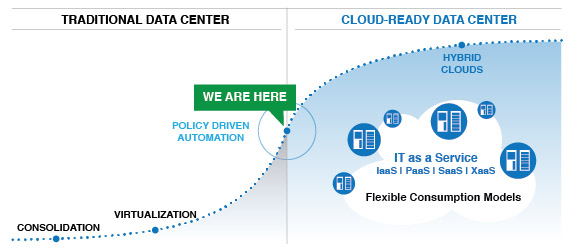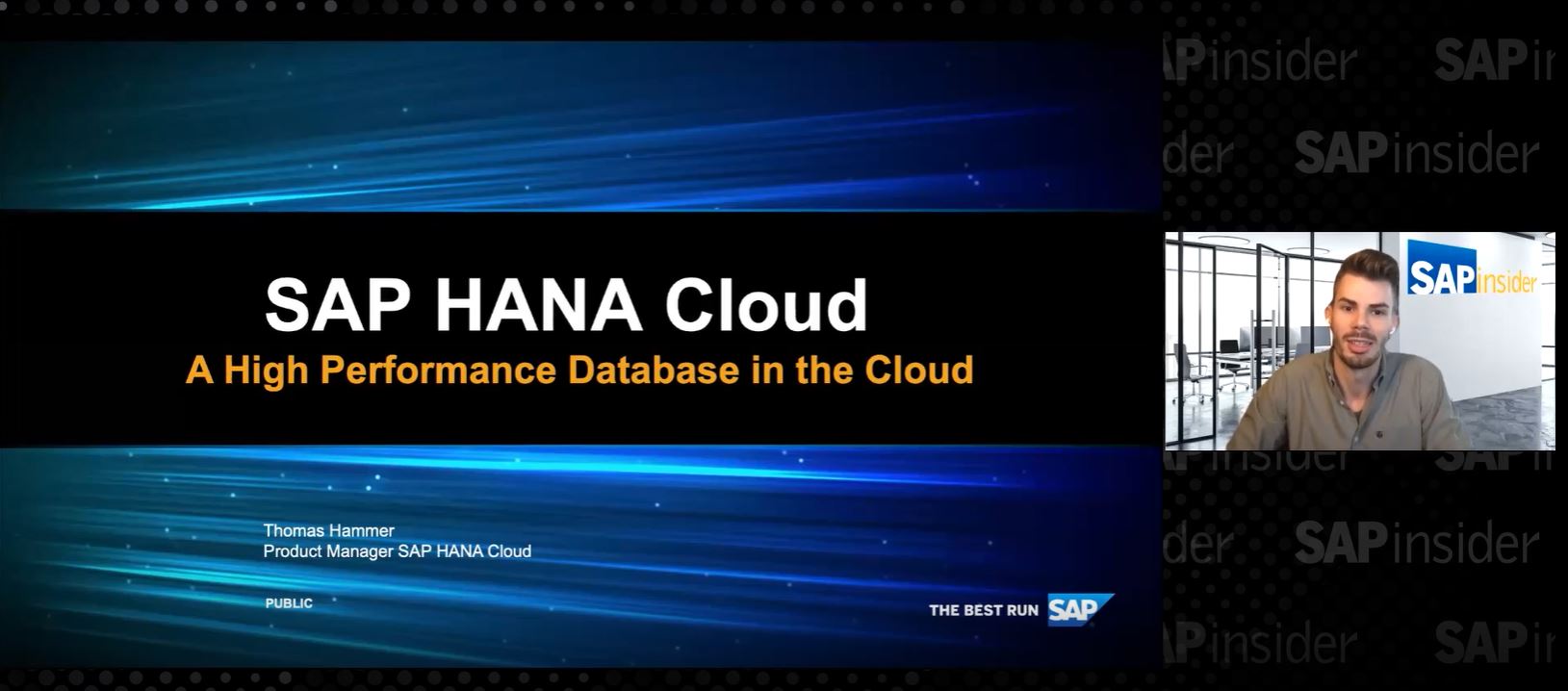Deploying SAP HANA in the Cloud
Integrated Infrastructure Means Simplified Adoption and Quick Time to Value
At SAPPHIRE NOW in May 2016, we surveyed more than 400 members of the SAP community, asking them a range of questions about their plans for their SAP landscapes. One question focused on SAP HANA: How were SAP customers planning to execute their next SAP HANA deployment? Of our sample, 68 people said they planned to deploy an on-premise appliance, 85 said they intended to leverage their existing infrastructure components and hardware via an SAP HANA tailored datacenter integration, and 257 — that’s 63% — said they planned to deploy SAP HANA in the cloud.
This answer may surprise some, with SAP HANA’s in-memory technology requiring significant hardware to process the volumes of data it encounters. But it’s yet another data point that indicates that the cloud is king in enterprise technology. SAP HANA is not an exception to this trend: Companies are increasingly interested in deploying its in-memory computing and big data analytics power through the cloud (see Figure 1). The cloud offers a level of flexibility, scalability, and ease of deployment that is appealing to many datacenter managers.

Explore related questions
The advantages of a cloud deployment are clear — so how do you get there? One way is with Cisco Unified Computing System (UCS), a converged architecture that integrates computing, networking, and storage, enabling efficiency and reliability along with centralized systems management.
Gaining Benefits, Reducing Management
In the SAP ecosystem, there are a number of certified SAP HANA cloud hosting providers offering services to assist businesses that want the SAP HANA experience without having to maintain the database itself on site. These companies run their business on providing the benefits of SAP HANA without interruptions and with minimal time spent on management on the part of the customer. They are deploying new clients every day, and they are constantly provisioning SAP systems — and the majority of them use Cisco UCS to deliver these services. In fact, we have found that 75% of these vendors run their infrastructure on Cisco UCS.
Take Virtustream, for example, which has completed 500 SAP HANA migrations to date for a variety of companies.1 “As more enterprises move SAP software to the cloud, we needed a partner that could help us expand our share of this rapidly growing market,” says Stacy Hayes, Vice President of Strategic Partnerships at Virtustream. Virtustream has truly set its business apart. It can offer customers dramatically improved SAP economics — up to 50% faster performance at up to 65% less cost—providing scalability and performance for mission-critical workloads.
Where Integration Meets Simplification
There are two main drivers that motivate customers to pursue SAP HANA adoption in the cloud with Cisco UCS. One is that Cisco UCS provides an integrated infrastructure, significantly reducing the need to manage different servers, systems, and components. The integration simplifies the hectic life of IT administrators, since networking, storage, and computing are in one place and are managed via one console. They can see how their systems are working and make changes efficiently, without any lengthy manual processes or double-checking. Administrators can then devote their time to other mission-critical activities, which provides savings for the organization in terms of resources used. This means that for the business, there’s no doubt that the different parts of the infrastructure are working together, and that computing resources can be allocated to the right project or business need at a moment’s notice.
Simple does not mean basic, though: The maximum efficiency achieved through the cloud means maximum performance. SAP customers don’t pursue cloud deployments of SAP HANA because they want fewer benefits than they would achieve on premise; they’re looking for the same functionality in a streamlined, easier-to-manage environment. With Cisco UCS, the big data that SAP HANA processes can be handled easily while maintaining high availability, so companies can be sure that their business data is available when they need it, and their mission-critical business processes are up and running around the clock.
Bluelock is an example of a company that can deliver this scenario to its customers on Cisco UCS technology.2 Bluelock’s customers span industries such as finance and healthcare, industries that produce lots of data and also have to navigate security and privacy standards — the Health Insurance Portability and Accountability Act (HIPAA), Payment Card Industry Data Security Standard (PCI DSS), or Health Information Technology for Economic and Clinical Health (HITECH), for example — while running their businesses. Churning through all this data requires significant computing power that is also extremely reliable, which is why Bluelock offers customers a service-level agreement (SLA) of 99.99% uptime. “With Cisco infrastructure, we can deliver high-availability solutions with industry-leading uptime,” says Bluelock’s Chief Technology Officer Pat O’Day.
The other main driver for choosing Cisco UCS is the use of service profiles. Service profiles work like templates, combining server and network details such as required server resources, identity information, firmware revision specifications, and connectivity definitions. By using service profiles, you don’t need to individually configure each element when provisioning. This is beneficial for SAP customers and hosting providers alike: Customers that might only be provisioning once a year no longer need to expend extensive time and resources rewriting the various required policies, and hosting providers that are provisioning constantly can achieve the same efficiencies again and again. This makes it a one-click exercise for provisioning — and even extends to the onboarding of a new application or user with Cisco Application Centric Infrastructure (ACI). With Cisco ACI, you can write policies based on security, for example, by defining who has access to a given application and how you want his or her profile to be recognized by the policies you’ve already written.
Cloud4com, which provides virtual data center services across Europe, benefits from the use of service profiles by being able to efficiently move workloads across servers.3 “We can move a service to another blade server in minutes using service profiles,” says Tomáš Novák, Chief Technology Officer at Cloud4com. “With Cisco UCS, it’s easy to provision servers for SAP HANA.” This boosts the company’s ability to support its customers with high-performance technology for running their business.
With an integrated infrastructure in one system and service profiles that can easily group disparate information, what previously took months to deploy can now take days or even hours — and once deployed, is easy to use and manage.
Strategic IT — Not Just a Cost Center
With improved efficiency and performance, Cisco UCS deployments have generated quick time to value and low total cost of ownership. One analysis found a 528% return on investment, with IT staff spending two-thirds less time simply keeping operations running.4 This means the company’s focus can remain where it should be: on the business.
Instead of IT thinking about how much time and how many resources need to be spent maintaining systems — without even considering the potential consequences of manual errors — it can instead play the role of strategic advisor to the business. This is so much more powerful than merely being a cost center on a balance sheet, as IT can provide critical input on the best way for the business to run projects, simplify processes, or develop and launch new products.
One of the ways this can be accomplished is through scalability. In an age of digital disruption, it’s essential that companies can scale their workloads rapidly and efficiently. With so much data coming in that companies rely on to make business decisions, IT needs to be able to advise on how best to process this data, and then scale up or out to accommodate it. In a converged architecture scenario, there are fewer moving parts to keep track of, and the smart infrastructure makes it easy to configure new additions and adjust whenever the business’s needs change.
Do What the Pros Do
The cloud is not some far-off technology for the future — it is here now. SAP HANA deployments in the cloud are gaining traction, and a converged infrastructure that minimizes complexity while delivering the results you need is a clear option. With 75% of the leading hosting companies betting their business on Cisco UCS for deployments of SAP HANA in the cloud, it merits consideration for other companies that are looking to do the same.
To learn more about how Cisco UCS can help you support the performance of your SAP HANA deployment, visit www.cisco.com/go/sap. For more success stories from certified cloud hosting providers using Cisco UCS, visit bit.ly/UCSstories.
1 See bit.ly/VirtustreamStory. [back]
2 See bit.ly/BluelockStory. [back]
3 See bit.ly/C4Cstory. [back]
4 IDC, “The Business Value of Cisco UCS Integrated Infrastructure Solutions for SAP Workloads” (March 2016; bit.ly/UCSforSAP). [back]




